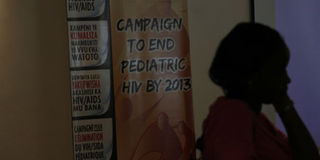Plan to fight mother-child Aids infection

A lady stands next to the campaign to end paediatric HIV and Aids banner at Panafric Hotel on January 26 2010. Photo/PHOEBE OKALL
A campaign to reduce Aids infection from mothers to their children by increasing coverage rates has been launched.
The three-year initiative--dubbed Campaign to end paediatric HIV and Aids (CEPA)--aims at increasing coverage rates for HIV transmission from mothers to children and scaling-up treatment to those infected.
Initially, the campaign will focus on six countries-- Kenya, Uganda, Tanzania, Mozambique, Zambia and Nigeria.
Speaking during the launch ceremony, a paediatrician, Dr Irene Inwani said on average, 102,000 pregnant women who were infected by HIV delivered either in hospitals or at home.
“Despite providing septrin treatment, about 40,000 children are infected by HIV annually and this is unacceptably high,” Dr Inwani said.
On his part, Dr Ibrahim Mohammed, the director of the National Aids and Sexually Transmitted Infections Programme, said the government was currently providing antiretroviral treatment to about 30,000 children living with the disease. According to estimates, 60,000 are in need of ARV treatment.
According to experts, Kenya is one of the 20 countries with the largest numbers of women needing antiretrovirals for preventing mother-to-child transmission of HIV contributing to the global gap to reach 80 per cent of those in need.
Currently, Kenya has about 1.4 million people living with HIV among them 150,000 children.
The campaign aims at increasing coverage rates for mother-to-child transmission from the average 30 to 40 per cent to the globally agreed target of 80 per cent.
This will be achieved through family-centred care and nutrition, early infant diagnosis and treatment, access to appropriate medications and adequate funding to scale up paediatric and maternal treatment.
Kenya Treatment Access Movement coordinator James Kamau urged the government to allocate funding for children living with the disease and avoid “over-reliance” on donor-funding.
Currently, the ARVs provided to children infected by HIV are accessed through the Clinton foundation.
At the same time, Mr Kamau faulted the government for failing to provide 15 per cent of its budgetary allocation to the Health sector as agreed during the Abuja Declaration in 2000.
During the meeting held in Abuja, Nigeria, heads of states and governments agreed to allocate 15 per cent of their national budgets to the health sector.
Kenya is a signatory to the declaration.
An estimated 420,000 new cases of paediatric HIV infection occurred in 2007, with over 90 per cent of these occurring in Kenya and other sub-Saharan Africa countries.




